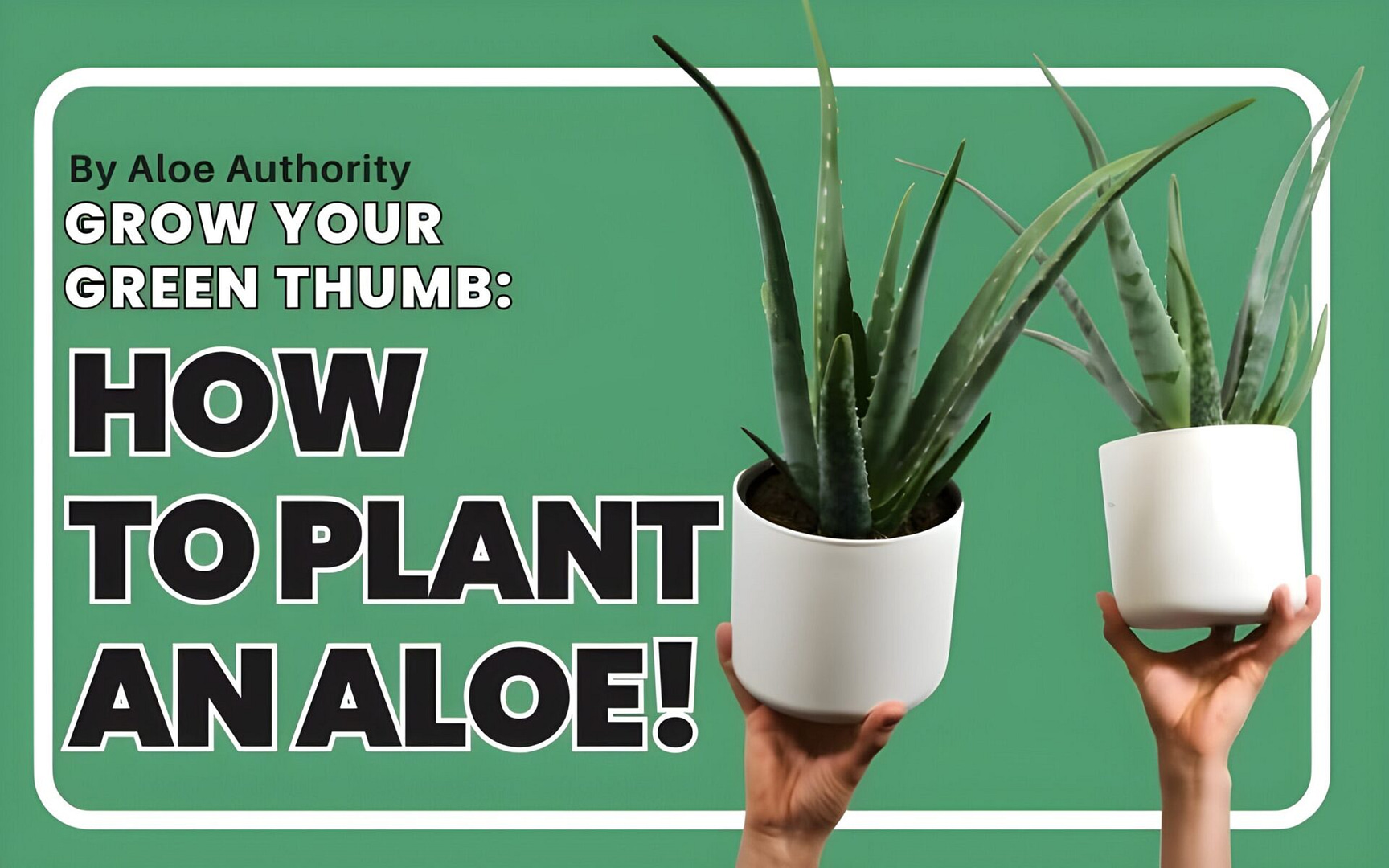Are you ready to add a touch of green to your home or garden? Planting an aloe is the perfect way to cultivate your green thumb and enjoy the beauty and benefits of these versatile plants.
Whether you’re interested in growing the popular Aloe Vera variety or exploring other types like Aloe arborescens or Aloe aristata, this guide will provide you with all the information you need to successfully plant and care for your aloe.
Key Points Before You Start:
- Choose the right type of aloe plant for your home or garden✅
- In indoor settings, provide your aloe vera plant with adequate sunlight and avoid overwatering✅
- In outdoor settings, select a well-drained bed and water the plant only during droughts✅
- Consider propagating aloe vera from leaf cuttings for new plants✅
- Maintain your aloe plant’s health by avoiding overwatering, pruning, and removing damaged leaves✅

How to Grow Aloe Vera Indoors
When it comes to growing aloe vera indoors, proper care and attention are key to ensuring its healthy growth. By following a few simple steps, you can create an ideal environment for your aloe plant to thrive.
Sunlight Requirements for Aloe
Like all plants, aloe vera requires an adequate amount of sunlight to grow and flourish. While aloe plants typically need 2-3 hours of sun when planted in the garden, indoors, they should be placed in a bright, sunny spot to receive sufficient light.
A south-facing window is often the best location. If natural light is limited, you can also use fluorescent grow lights to supplement the sunlight.
Soil for Aloe Plants
The right soil is essential for the proper growth of aloe vera plants. They thrive in well-drained soil that allows excess water to flow out easily, preventing waterlogged roots.
You can use a commercial succulent mix or create your own by combining equal parts of potting soil, sand, and perlite. This mixture provides the drainage and aeration that aloe plants need to thrive.
Aloe Plant Watering
Proper watering is crucial for the health of your aloe vera plant. Overwatering can lead to root rot and other issues, so it’s important to find the right balance. Water your aloe plant deeply but infrequently, allowing the soil to dry out fully between waterings.
This usually translates to watering the plant every two weeks. Before watering, insert your finger into the soil to check for dryness about an inch below the surface.
Remember, it’s always better to underwater than overwater your aloe plant. Aloe vera is a succulent and can tolerate drought, but not excess moisture.

How to Grow Aloe Vera Outdoors
With these simple steps, you can successfully grow aloe vera indoors and enjoy the beauty and benefits of this versatile plant.
If you live in a warm climate (Zone 10 or higher), you can grow aloe vera outdoors year-round. Aloe vera is a resilient plant that can thrive in various conditions, making it an ideal choice for outdoor gardening.
Follow these tips for successful aloe propagation, growing, and maintenance:
Choose the Right Location
When selecting a spot to plant your aloe vera outdoors, ensure it receives plenty of sunlight, as aloe plants thrive in bright light conditions. Find a well-drained bed or container with good soil drainage to prevent waterlogging and root rot.
Water Smartly
Aloe vera is a drought-tolerant plant, and overwatering can be detrimental to its growth. Only water your aloe plant during dry periods, allowing the soil to dry out between waterings. This will prevent waterlogged roots and keep your plant healthy.
Maintain and Prune
Regular maintenance is crucial for the healthy growth of your outdoor aloe vera plant. Remove spent flower stalks to encourage new growth and trim damaged leaves to maintain its aesthetic appeal. This will promote overall plant health and vitality.
“Growing aloe vera outdoors is a rewarding experience. With the right care and attention, your aloe plant will thrive and provide you with its healing properties for many years to come.”
For a comprehensive guide on aloe propagation, tips for growing aloe, and plant maintenance, refer to the table below:
| Aloe Propagation Guide | Tips for Growing Aloe | Aloe Plant Maintenance |
|---|---|---|
| – Propagate aloe plants from leaf cuttings | – Choose a well-drained location | – Remove spent flower stalks |
| – Ensure leaf cuttings are one-fifth the size of the parent plant | – Water sparingly, only during droughts | – Trim damaged leaves |
| – Plant cuttings in a new pot with potting mix | – Provide ample sunlight | – Maintain a healthy watering schedule |
| – Allow cuttings to sit for one week before watering | – Regularly monitor plant health | – Prune as needed |
Follow these guidelines, and you’ll be well on your way to cultivating a thriving outdoor aloe vera garden. With minimal effort and proper care, you’ll enjoy the beauty of your aloe plants and all the benefits they provide.

How to Grow Aloe Vera from Leaf Cuttings
If you’re looking to expand your collection of aloe plants, propagating aloe vera from leaf cuttings is a great way to do it. While the success rate may be low, it’s worth giving it a try to grow new aloe plants from cuttings. Follow these steps to propagate aloe vera and multiply your green treasures.
➡️Step 1: Choose the Right Cutting
To ensure successful propagation, select a leaf cutting that is at least one-fifth the size of the parent plant. Look for a healthy leaf without any signs of damage or disease. Using a clean, sharp knife, carefully remove the selected leaf from the parent plant.
➡️Step 2: Prepare the Potting Mix
Prepare a suitable potting mix for the aloe leaf cutting. A well-draining mix, such as a succulent or cactus mix, is ideal for aloe propagation. Fill a small pot with the potting mix, leaving some space at the top for the cutting.
➡️Step 3: Plant the Cutting
Create a small hole in the potting mix and gently place the cutting into the hole. Ensure that the cut end of the leaf is inserted into the potting mix, with the leaf standing upright. Press the potting mix around the base of the cutting to secure it in place.
➡️Step 4: Allow the Cutting to Callus
After planting the cutting, allow it to sit undisturbed for about one week in a warm, dry location. This period allows the cut end of the leaf to callus, which helps prevent rotting when watered.
➡️Step 5: Provide Adequate Sunlight and Water
Place the pot in a location that receives bright, indirect sunlight. Aloe cuttings need sunlight to photosynthesize and establish roots. Water the cutting lightly, using a spray bottle or by misting the soil, to prevent overwatering.
➡️Step 6: Care for the Young Plant
As the cutting starts to develop roots, gradually increase the amount of water given. Once the plant shows signs of new growth, such as new leaves or roots emerging from the soil, you can treat it as a mature aloe vera plant.
Tip: Keep in mind that not all aloe leaf cuttings will successfully root and grow into new plants. Be patient and persistent, as it may take some trial and error to achieve success.

How to Care for Aloe Vera
To ensure the health and vitality of your aloe vera plant, proper care is essential. By following a few simple guidelines, you can keep your plant thriving and enjoy its many benefits.
Watering
Avoid overwatering your aloe vera plant, as it can lead to root rot. It is best to water the plant only when the soil is dry. Before watering, check the moisture level by inserting your finger into the soil about an inch.
If it feels dry, it’s time to water the plant. Ensure that the pot has good drainage to prevent water from pooling at the bottom, which can cause root rot.
Fertilizing
Aloe vera generally does not require regular fertilization. However, if you choose to fertilize your plant, use a low nitrogen, high phosphorus fertilizer once a year in the spring. This will provide the necessary nutrients without over-stimulating growth, which can be detrimental to the plant’s overall health.
Pruning
Regular pruning is important for maintaining the health and appearance of your aloe vera plant. Trim away any damaged or yellowing leaves to promote new growth and prevent the spread of disease. Use clean, sharp scissors or pruning shears to make clean cuts, avoiding any tearing or crushing of the leaves.
Common Care Mistakes for Aloe Vera
| Mistake | Consequence |
|---|---|
| Overwatering | Root rot, yellowing leaves |
| Underwatering | Drying out, shriveled leaves |
| Excessive Fertilization | Burned roots, stunted growth |
| Infrequent Pruning | Overcrowded growth, lower vigor |
Remember, caring for your aloe vera plant is not only about maintaining its health but also about enhancing its beauty and aesthetics. Regular care ensures that your plant remains vibrant and serves as a stunning addition to your indoor or outdoor space.
With proper watering, occasional fertilization, and regular pruning, your aloe vera plant will continue to thrive and provide you with its incredible healing properties for years to come.

Conclusion
By following the proper techniques for planting and caring for aloe plants, you can enjoy their beauty and benefits in your home or garden. Whether you choose to grow aloe vera indoors or outdoors, it is important to provide the plant with adequate sunlight, well-drained soil, and proper watering.
Regular maintenance, such as pruning and removing damaged leaves, ensures the health and vitality of the plant. With the right care, your aloe plants will thrive and provide you with their healing properties for years to come.
Remember to avoid overwatering your aloe plants, as this can lead to root rot. Allow the soil to dry out between waterings and provide adequate drainage to prevent waterlogged roots. Additionally, ensure that your aloe plants receive enough sunlight, as they require bright light to grow properly.
➡️Aloe Vera Growing Tips for Lush, Healthy Plants 👈🏻🌵🤫
FAQ
How do I plant an aloe?
To plant an aloe, choose the right type of aloe plant for your home or garden. Use well-drained soil or a special succulent mix when planting aloe vera to ensure its proper growth. Allow the soil to dry out fully before watering the plant, and provide adequate sunlight for its growth.
How much sunlight does aloe vera need indoors?
Aloe vera requires 2-3 hours of sun a day in the garden, but when grown indoors, it should be placed in a bright, sunny place. Make sure it receives enough sunlight to thrive.
Can aloe vera be grown outdoors?
Yes, aloe vera can be grown outdoors in warm climates (Zone 10 or higher). Choose a well-drained bed for planting and water the plant only during droughts. Aloe vera is tolerant of average home temperatures and dry air commonly found indoors.
How can I propagate aloe vera from leaf cuttings?
To propagate aloe from leaf cuttings, ensure that the cutting is at least one-fifth the size of the parent plant. Carefully remove the baby plant from the base of the parent plant and plant it in a new pot with potting mix. Allow the cutting to sit for one week before watering and provide adequate sunlight and water for successful growth.
How should I care for aloe vera?
Avoid overwatering the plant as it can cause root rot. Water the plant only when the soil is dry and ensure the pot has good drainage. Fertilizing is not necessary, but if you choose to fertilize, use a low nitrogen, high phosphorus fertilizer once a year in the spring. Regular pruning and removing damaged leaves help maintain the health and appearance of the plant.





